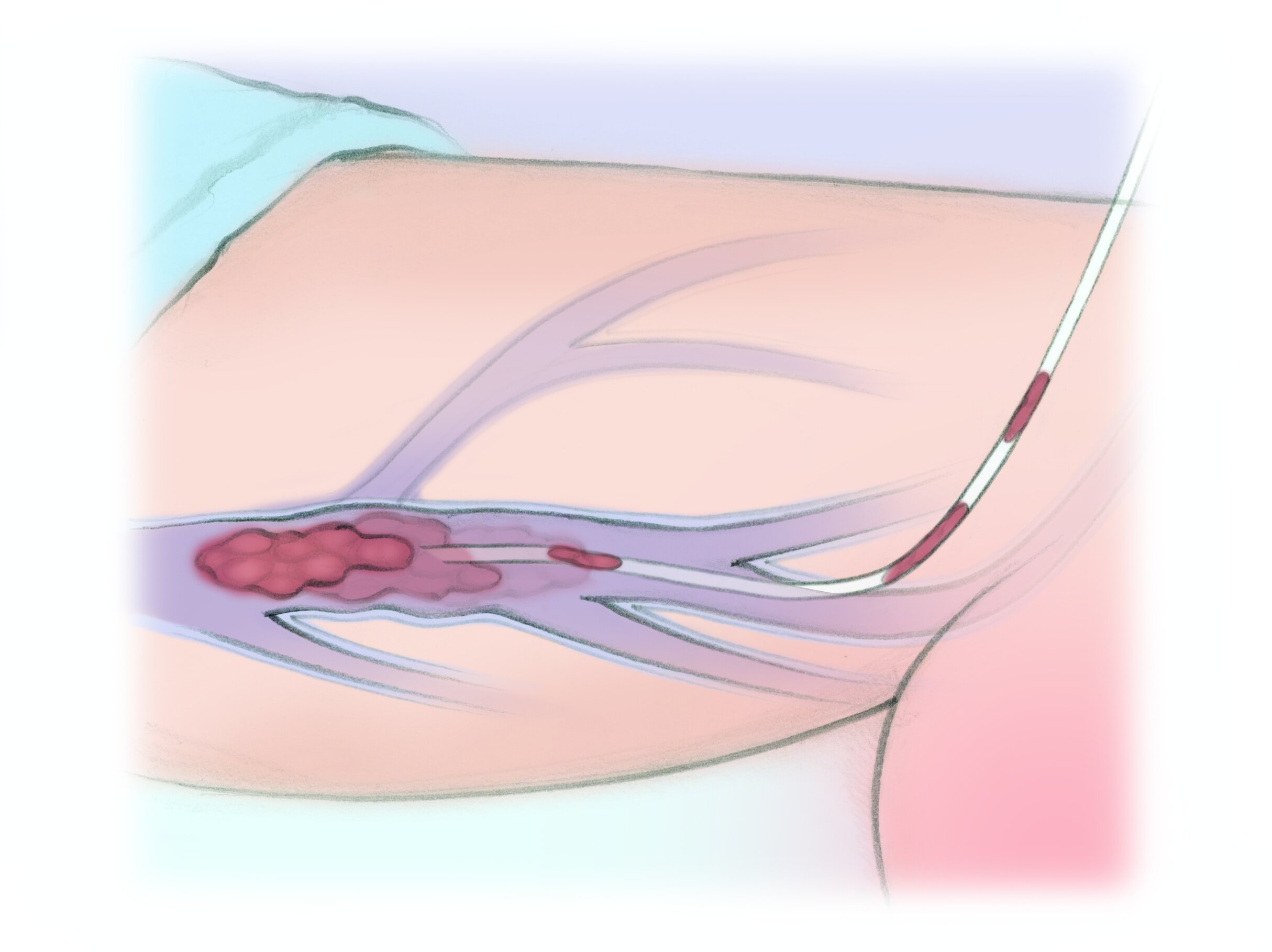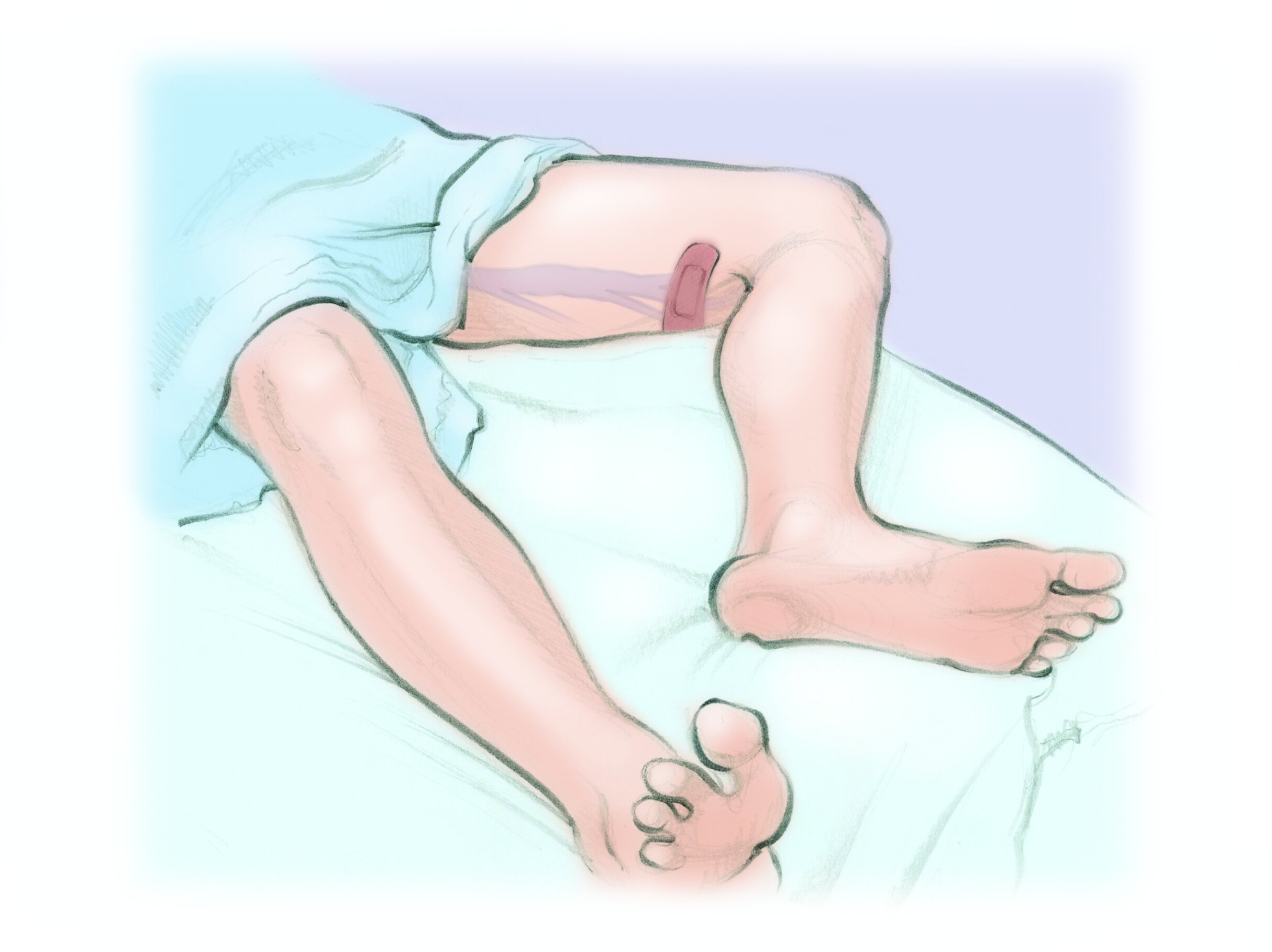What is a DVT?
A deep vein thrombosis (DVT) is a blood clot in the deep veins of the legs, pelvis, or arms. Blood flows through the vessels like water in a pipe. When a blood vessel is narrowed, damaged, or scarred, a blood clot can form. They can also form in people who do not move enough or who have blood clot disorders.
Larger clots can cause severe pain and swelling. If a clot breaks off and travels to the lungs, it is a life-threatening condition called a pulmonary embolism (PE). Over time, DVTs can also damage the veins. This can cause limb swelling, ulcers, and pain called post-thrombotic syndrome (PTS).
How is DVT treated?
Most DVTs can be treated with blood thinners to prevent new clots from forming while the body clears the DVT over time. People with severe symptoms or a high risk of developing a PE or PTS may benefit from a minimally invasive procedure to dissolve the blood clot (called thrombolysis) or remove it (called thrombectomy).
The clinician starts by cleaning and numbing the skin over a vein in the neck, top of the thigh, or back of the knee or ankle. Then they thread a tiny tube into the vein using moving x-rays to guide it to the clot.
Sometimes they can suck out the clot or break it up (thrombectomy). Other times, they dissolve the clot by slowly dripping clot-busting medicine through a tiny soaker hose-like tube (thrombolysis). This can take hours to days, and you have to be watched closely in the intensive care unit (ICU). You may not be allowed to get out of bed or eat during this time. You may also have another procedure to make sure the clot has improved. The tube is then removed and a bandage is placed over the wound.
Thrombectomy / Thrombolysis for DVT
1. After numbing the skin, a tiny tube is threaded into a vein and to the blood clot.
2. The clot is sucked out (thrombectomy) or slowly dissolved (thrombolysis).
3. The tube is removed and a bandage is placed over the pinhole in the skin.
What are the risks?
DVT Thrombectomy / Thrombolysis are generally safe procedures when done by a specialist.
1 in 2 people will still develop PTS after treatment for DVT.
6 in 100 people will have bleeding over the next 2 years. Since the treatment of DVT relies on blood-thinning medicines, bleeding is the main risk. The risk of serious bleeding in the brain or other parts of the body depends on your other health problems.
Less than 5 in 100 people experience clot breaking off and traveling to the lungs
Less than 2 in 100 people develop damage to the blood vessels, experience bleeding, develop infection
What are the alternatives?
Your options will depend upon your specific health issues and preferences. Your clinician will be able to help you explore your options, including a combination of the treatments below.
Alternative 1 No treatment. This avoids any risks or discomfort of treatment but has the highest risk of the clot not going away. If the clot stays, the symptoms will likely not improve. Up to 1 in 2 of untreated people will develop PE because the clot travels to the lungs - this can be life-threatening.
Alternative 2 Most DVTs are treated with blood thinners. This prevents the clot from growing while the body breaks down the clot. This option avoids a procedure and has less bleeding risk (4 in 100 people have major bleeding) but is less effective for large or high-risk clots. With this treatment, 2-5 in 100 people have clot travel to the lungs (PE).
Alternative 3 Clot-busting medicine (”tPA”) through an IV plus blood thinners. This option has a higher bleeding risk (9 in 100 people) since the medicine is not targeted to the clot.
Alternative 4 Surgery to remove the clot. This is avoided because it has a much higher risk of complications and often does not work for very long.
Frequently asked questions
What is a blood clot?
Blood usually flows through your vessels like water in a pipe. When you get hurt and bleed, blood can form a blob of thick jelly called a clot. Blood clots help your body to stop bleeding and start healing itself.
What is an abnormal blood clot?
When a blood clot forms in an open blood vessel, it can block blood flow. This can happen when the blood vessel is narrowed, damaged, or scarred. Abnormal blood clots can form when a person does not move for long periods of time. Abnormal blood clots can also form in people who have diseases that cause them to make clots too easily.
A vein is a blood vessel that carries blood from the body back to the heart. Sometimes a blood clot can form in the big veins deep in the pelvis or legs. This can cause swelling and pain as the blood backs up in the legs, unable to get back to the heart.
Are abnormal blood clots dangerous?
If a clot in a deep vein breaks off and travels to the lungs, it can block the lung vessels and cause life- threatening shortness of breath. This is an emergency.
If the deep vein clot does not clear up naturally or with medication, it can damage the vein. Damaged veins cannot carry blood back to the heart normally, so patients can experience long-term swelling, pain, and skin sores. This condition can reduce a patient’s quality of life.
It is rare but sometimes the blood clot in the deep veins of the pelvis and legs is so big that blood cannot flow out of or into the leg. If doctors cannot open the vein, the patient could lose their leg. This is an emergency.
What are the treatments for abnormal blood clots?
Most blood clots can be treated with medicines given through an IV. These medications, called blood thinners, keep new clots from forming.
Patients with severe symptoms from a blood clot in the lungs or deep veins need treatments to remove the clot. Doctors can give clot-busting medicines to the entire body through an IV.
Specialized doctors can perform a minimally invasive, image-guided procedure (MIIP) to dissolve the clot faster and with smaller amounts of clot-busting medicines by giving them directly into the clot through a tiny tube. This targeted approach carries a lower risk of bleeding than when the medicine is given to the entire body.
How can a MIIP treat abnormal blood clots?
A specialized doctor numbs the skin then inserts a tiny tube into a large vein in the neck, groin or leg. Using moving x-rays to see inside the body, the specialized doctor then guides the tube over a soft wire through the veins and to the blood clot. The doctor sprays clot-busting medicines into the clot through many tiny holes in the tube. Sometimes the clot dissolves immediately but other times the clot needs treatment with the clot-busting medicine for several hours or overnight. The clot dissolves and symptoms improve. The doctor removes the tiny tube and covers the pinhole with a Band-aid. This treatment can save lives.
For more information:
http://jamanetwork.com/journals/jama/fullarticle/1486833?resultClick=24
http://www.mayoclinic.org/diseases-conditions/deep-vein-thrombosis/basics/definition/con-20031922
http://jamanetwork.com/journals/jama/fullarticle/2297171?resultClick=1
http://jamanetwork.com/journals/jama/fullarticle/896217?resultClick=1
For more information on blood clots in the lungs:




